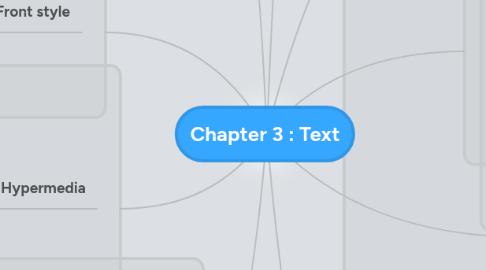
1. Front style
1.1. Boldface, Italic, Underlining and Outlining.
2. Font Terminology
2.1. 1. Baseline : the line on which the bases of characters are arranged
2.1.1. 2. Cap Height : cap height refers to the height of a capital letter.
2.1.1.1. 3. X-height : The distance between the baseline and the top of a lower-case letter x.
2.1.1.1.1. 4. Kerning : adjustment of space between certain pairs of letters to make them look more uniform.
3. Hypertext vs Hypermedia
3.1. Hypertext is a text which contains links to other texts. The term was invented by Ted Nelson around 1965. It is the subset of hypermedia.
3.1.1. Hypermedia is not constrained to be text-based. It can include other media, e.g : graphics, image, and especially the continuous media- sound and video.
4. Hypermedia structures
4.1. 1. Links are connections between conceptual elements and are the navigation pathways and menus.
4.1.1. 2. Nodes are accessible topics, documents, messages, and content elements. It links form the backbone of a knowledge access system.
4.1.1.1. 3. Anchors is defined as the reference from one document to another document, image, sound, or file on the web.
5. Serif versus sans serif
5.1. A Serif is the little decoration at the end of a letter stroke. Serif fonts are used for printed media or documents that have large quantities of text.
5.1.1. Sans serif fonts do not have decoration at the end of a letter stroke. It used for headlines and bold statements It is considered better for computer displays.
6. Text elements in a Multimedia Presentation
6.1. Menus for navigation
6.2. Interactive buttons
6.3. Fields for reading
6.4. HTML documents
6.5. Symbols and icons
7. Bitmap vs Vector
7.1. Bitmaps font consist of a matrix of dots or pixels representing the image. Besides, it's file size increases as more sizes are added, require a lot of memory and non-scalable.
7.1.1. Vector fonts drawing use instructions and mathematical formulae to describe each glyph. It's file size is much smaller than bitmaps and TrueType, OpenType and PostScript are vector font formats.

